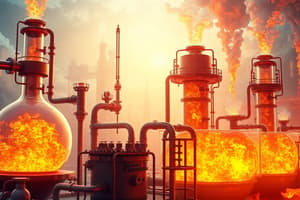Podcast
Questions and Answers
What technique is primarily used to separate a liquid mixture based on differences in boiling points?
What technique is primarily used to separate a liquid mixture based on differences in boiling points?
- Simple Distillation
- Gas Chromatography
- Fractional Distillation (correct)
- Filtration
Under what condition is simple distillation most effectively used?
Under what condition is simple distillation most effectively used?
- For gaseous mixtures.
- For ionic compounds only.
- For compounds with boiling points more than 100 o C apart. (correct)
- For compounds with boiling points less than 50 o C apart.
What is the total vapor pressure (Ptot) above a mixture of 0.5 moles of compound A and 0.5 moles of compound B, given that PA is 1000 torr and PB is 520 torr?
What is the total vapor pressure (Ptot) above a mixture of 0.5 moles of compound A and 0.5 moles of compound B, given that PA is 1000 torr and PB is 520 torr?
- 880 torr
- 760 torr (correct)
- 1000 torr
- 7600 torr
How is the percentage composition of component A in the vapor phase determined?
How is the percentage composition of component A in the vapor phase determined?
After the first distillation of A and B, what will be the composition of the condensed liquid for A if % A in the vapor phase is 65.8%?
After the first distillation of A and B, what will be the composition of the condensed liquid for A if % A in the vapor phase is 65.8%?
What is the expected purity of component A after a second simple distillation if the vapor phase composition is 65.8%?
What is the expected purity of component A after a second simple distillation if the vapor phase composition is 65.8%?
What happens to the boiling point of a mixture after a successful distillation if component A is more volatile than component B?
What happens to the boiling point of a mixture after a successful distillation if component A is more volatile than component B?
Which of the following statements is true regarding the partial pressures in a distillation process?
Which of the following statements is true regarding the partial pressures in a distillation process?
What is the primary reason for using packing material in fractional distillation?
What is the primary reason for using packing material in fractional distillation?
How is the height equivalent of theoretical plates (HETP) calculated?
How is the height equivalent of theoretical plates (HETP) calculated?
What is the formula to determine the total number of plates in fractional distillation?
What is the formula to determine the total number of plates in fractional distillation?
What is the significance of theoretical plates in fractional distillation?
What is the significance of theoretical plates in fractional distillation?
What does the variable nC / nT represent in the context of gas chromatography?
What does the variable nC / nT represent in the context of gas chromatography?
What is the first step in the fractional distillation procedure?
What is the first step in the fractional distillation procedure?
During the distillation process, what happens to the vapor as it rises through the column?
During the distillation process, what happens to the vapor as it rises through the column?
What should be the state of the material collected when completing the fractional distillation?
What should be the state of the material collected when completing the fractional distillation?
What is the main hazard to consider while performing this distillation?
What is the main hazard to consider while performing this distillation?
What should you do after collecting a total of 2 mL of distillate?
What should you do after collecting a total of 2 mL of distillate?
Flashcards are hidden until you start studying
Study Notes
Fractional Distillation
- Fractional Distillation separates components by their boiling points.
- Components need to have significantly different boiling points for effective separation.
- The process is achieved by packing the distillation column with material that provides surface area for condensation and re-boiling of vapors.
- This repeated condensation and re-boiling process enriches the vapor in the lower boiling component.
- The number of theoretical plates in the packing material determines the efficiency of the column which can be determined by calculating the HETP (height equivalent of theoretical plates).
Gas Chromatography (GC)
- GC is used to analyze the composition of mixtures.
- The sample is injected into a column and separated based on the components' interactions with the stationary phase.
- The area under each peak is proportional to the amount of the corresponding component.
- GC is employed in this experiment to determine the molar ratio of cyclohexane (nC) to toluene (nT) in the HETP fraction, which is crucial for calculating the HETP value.
Experiment 4: Purification of Petroleum Hydrocarbons
- The experiment involves fractional distillation of a 50/50 mixture of cyclohexane and toluene.
- The HETP value for the packing material is determined using the GC analysis of collected fractions.
- The first few drops collected (HETP fraction) are enriched in the lower boiling component (cyclohexane).
- The temperature range at which the first 2 mL of distillate (fraction 1) is collected provides information about the separation process.
- Fraction 2, representing the remaining liquid in the round bottom flask, is also analyzed by GC.
Data Analysis
- The ratio of cyclohexane to toluene (nC /nT) in the HETP fraction is calculated using the peak areas from the GC analysis.
- The formula nC /nT = 1.2(PC /PT) relates the peak areas (PC and PT) of cyclohexane and toluene, respectively, to the molar ratio.
- This ratio is crucial to calculate the total number of theoretical plates in the column using the equation: Total # of plates = [log(nC /nT)/log2.33]
- Subtracting 1 from the total number of plates accounts for the single plate contributed by the glassware outside the column.
- Finally, HETP is calculated using the following formula: HETP = height of packing material (cm) / # of theoretical plates in packing material.
Hazards
- Be cautious of hot surfaces and open flames when working with volatile organic compounds.
Studying That Suits You
Use AI to generate personalized quizzes and flashcards to suit your learning preferences.




